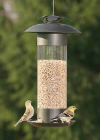-
So What’s the Best Tube Bird Feeder for Spring?
With spring in bloom (in much of the country anyway) there’s an instinct among nature types to get outdoors and work in the garden! For many, wild birds go hand-in-hand with love of gardening. Like the “eyes bigger than stomach” syndrome at a restaurant, heading into nurseries can easily turn into more than one bargained for! We know this first hand, as flowers sit in the driveway waiting to be planted.
Luckily for perennials like these crocus, color emerges effortlessly year after year. It also signals the beginning of nesting season for resident birds, and the migratory start for our southern feathered friends.
On the birding side, it’s a perfect time to give feeders a good cleaning, check birdhouses for old nests and clean them out too. Avoid leaving old nests on the ground near birdhouses as this attracts predators. Lots of fancy cleaners on the market, but a solution of bleach and water (1:10 ratio) is ideal. Scrub, rinse well, air dry… pretty simple.
If you’re just getting into the birding thing (lots of folks are these days) – where to start? So many feeders and gadgets out there! Fresh water and a
tube bird feeder are a great place to start! All birds are attracted to fresh water, be it a traditional birdbath, or simple pan of shallow water. Shallow’s the optimal word, 2-3-inches maximum is recommended. Something with texture too, as bird’s feet can get a better grip. Small rocks or pebbles in the bowl help with landing and perching.
So, what’s the best tube feeder? Like the bath, or anything else for that matter… it’s the one you will maintain! Feeders need to be filled fairly consistently, as well as cleaned. Wet, moldy seed serves no purpose at all, and birds will quit visiting a feeder with nasty contents. Plus it can spread disease among the local avian buddies in your yard.
Consider who you’d like to attract too. Thistle or nyjer seed is made for tube feeders, they have tiny ports for this tiny seed. Goldfinches, house and purple finches, siskins, buntings and redpolls enjoy thistle. Say you want a more “all-around” type feeder for chickadees, titmice, cardinals, nuthatches and some of the other usual suspects? You can’t beat a tube feeder with sunflower seed! It’s popular among many species and a great choice for a first or only feeder.
Some offer generous seed trays that make it easy for cardinals to feed. Although there are some general thoughts as to who will eat where, this winter proved all bets were off! Cardinals seen eating at suet feeders, juncos at sunflower feeders, and some other strange sightings due to the extreme weather.
The other really nice thing is that you can buy this seed sans the shell. Sunflower hearts (or meats) is a waste-free food that leaves hardly any ground mess. Whatever should fall to the ground is usually gobbled up by ground feeding birds like doves, juncos or chipping sparrows. It costs a few dollars more, but we think it’s well worth it! Cheaper seed leaves more waste because of the fillers most birds peck out and discard… so where’s the value?
In choosing a new tube bird feeder, pick one with sturdy construction that you know will last. Although inexpensive, plastic isn’t always the best choice as squirrels can and likely will chew it to bits. Ceramic is chew-proof, as is copper, stainless steel, and many of the newer materials used to hand craft or manufacture quality bird feeders.
Your birds will thank you! -
A Tube Birdfeeder: Perch or Cling?
To Perch or Cling? Tube feeders come in a multitude of styles, accommodating nyjer seed, peanuts, and most birdseed mixes. Depending on what birds you’re looking to attract, and what you’re feeding should dictate the type of tube birdfeeder you’ll use.
For attracting Goldfinches with Thistle or Nyjer seed, both types of feeders work well. The advantage to a clinging-type feeder is that more feeding space is available, you’ll likely see more birds at the feeder at one time.
If you’re looking to attract multiple species with Black Oil Sunflower seed for example, a tube feeder with perches will allow each bird its own space.
Both types of work well, the important thing is to keep fresh food available, and keep feeders clean to prevent the spread of bacteria among gathering birds in your yard.
-
Versatile Tube Birdfeeders
Some Bird feeders are very specialized for specific species, but with traditional Tube Bird Feeders you can be sure to attract many types of songbirds. They accommodate a variety of seed mixes which can be changed or rotated for greater species attraction. Some tube birdfeeders even have 2 or 3 individual tubes so you can use multiple types of seed in one feeder.
Large capacity tube feeders are great as you can spend less time filling and more time viewing your wild birds. Tube feeders are available in a variety of materials and colors, from basic, no-frills–to decorative and whimsical designs. Choose one that is easy to maintain as far as filling and cleaning…you’ll be glad you did!

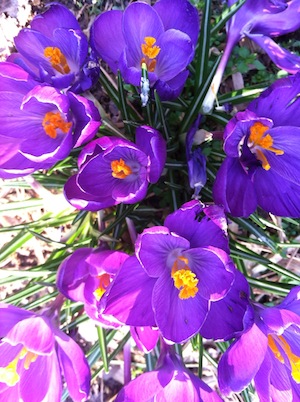
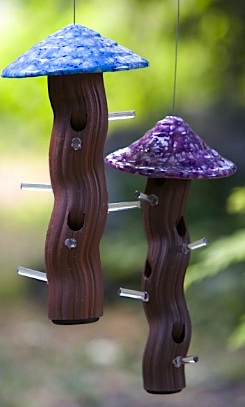
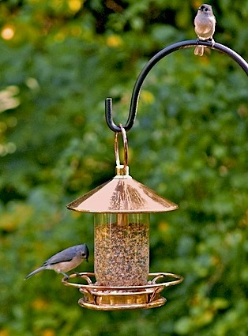
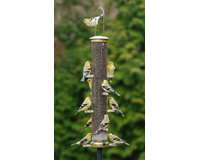 To Perch or Cling? Tube feeders come in a multitude of styles, accommodating nyjer seed, peanuts, and most birdseed mixes. Depending on what birds you’re looking to attract, and what you’re feeding should dictate the type of
To Perch or Cling? Tube feeders come in a multitude of styles, accommodating nyjer seed, peanuts, and most birdseed mixes. Depending on what birds you’re looking to attract, and what you’re feeding should dictate the type of 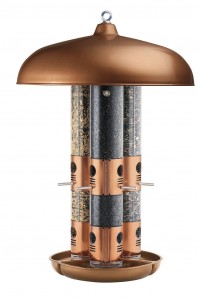 Both types of work well, the important thing is to keep fresh food available, and keep feeders clean to prevent the spread of bacteria among gathering birds in your yard.
Both types of work well, the important thing is to keep fresh food available, and keep feeders clean to prevent the spread of bacteria among gathering birds in your yard.